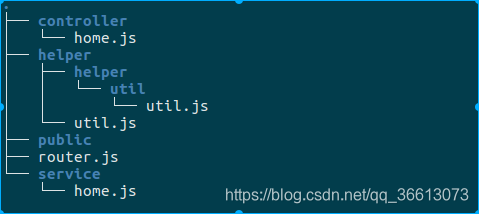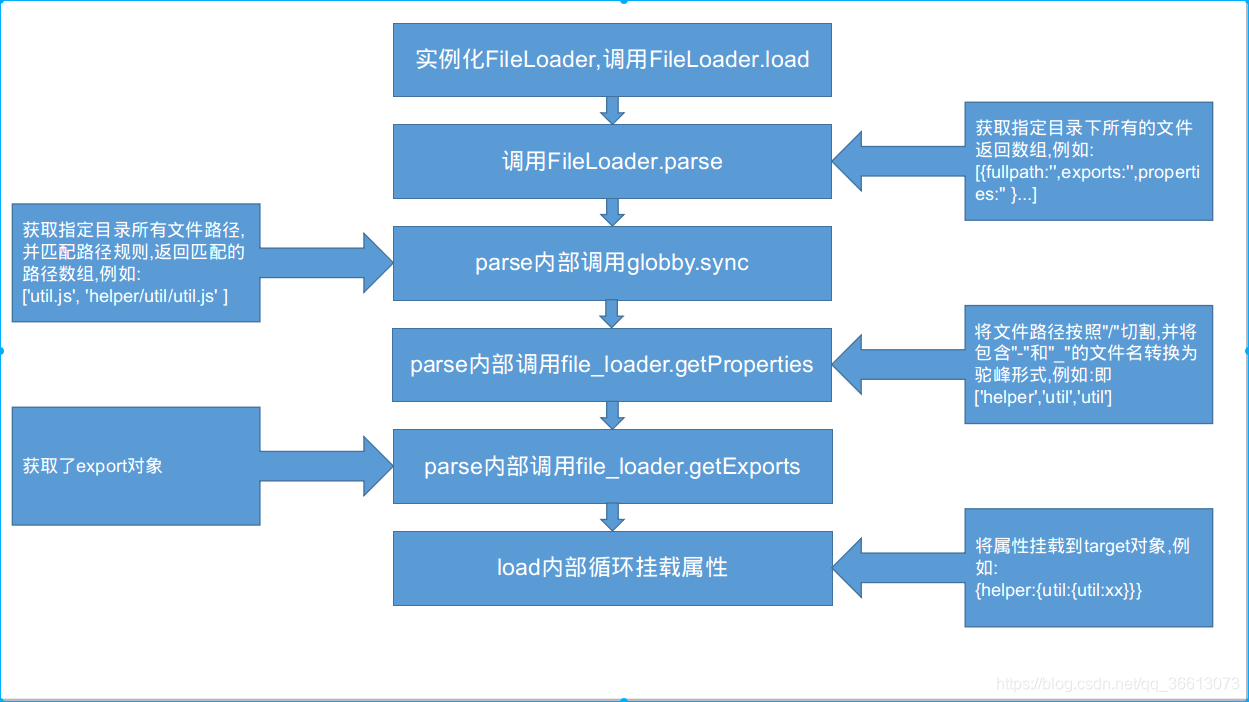开发egg-helper插件目的
- 所有的工具函数维护在 app/util 文件内,在使用时需要手动require,如果多个文件使用,需要多个require,致使业务代码实现不优雅
- 在工具函数内部无法直接读取配置文件,通常是使用传参的方式
- Egg也提供Helper框架扩展,但是需将工具函数维护在 app/extend/helper.js 文件内,我更倾向于单独维护
开发经历
第一版
使用egg官方文档提供的loadToContext方法,将 app/helper 内所有文件挂载到ctx.helper对象
loadToContext官方文档,请戳这里
代码实现
// --------egg-helper/app.js -------
module.exports = app => {
const dir = app.loader.getLoadUnits().map(unit => {
return path.join(unit.path, 'app/helper');
});
app.loader.loadToContext(dir, 'helper', {
inject: app,
call: true,
});
};
...
缺点:
- 覆盖掉原有的ctx.helper对象(这里可以选择修改挂载属性名称来避免覆盖,但为了和egg保持一致,所以未选择此方案)
源码学习
打开egg-core工程,根据package.json找到入口文件
...
// -------- egg-core/index.js -------
module.exports = {
EggCore,
EggLoader,
BaseContextClass,
utils,
};
在index.js文件内,export出四个对象
EggCore:
egg核心类
- 继承于koa Application
- 初始化egg Application的对象方法和属性
// -------- egg-core/lib/egg.js -------
...
class EggCore extends KoaApplication {
constructor() {
...
const Loader = this[EGG_LOADER];
assert(Loader, "Symbol.for('egg#loader') is required");
this.loader = new Loader({ // 实例化loder,即EggLoader
baseDir: options.baseDir,
app: this,
plugins: options.plugins,
logger: this.console,
serverScope: options.serverScope,
});
const Controller = this.BaseContextClass;
this.Controller = Controller; // 定义Controller使用基类
const Service = this.BaseContextClass;
this.Service = Service; // 定义Service使用基类
...
}
}
...
EggLoader:
egg-core核心类
- 提供load方法,例如loadToContext、loadToApp
- 提供获取egg基础信息方法和属性,例如 getAppInfo
- 挂载 /lib/loader/mixin目录下定义的load函数,具体加载顺序在 egg/lib/loader/appworkerloader.js中定义
// -------- egg-core/lib/loader/egg_loader.js -------
class EggLoader {
...
// 将property挂载到ctx
loadToContext(directory, property, opt) {
opt = Object.assign({}, {
directory,
property,
inject: this.app,
}, opt);
const timingKey = `Load "${String(property)}" to Context`;
this.timing.start(timingKey);
new ContextLoader(opt).load(); // 实例化ContextLoader
this.timing.end(timingKey);
},
// 获取当前 应用/框架/插件下所有文件路径,返回路径数组
getLoadUnits() {
if (this.dirs) {
return this.dirs;
}
const dirs = this.dirs = [];
// 插入插件路径
if (this.orderPlugins) {
for (const plugin of this.orderPlugins) {
dirs.push({
path: plugin.path,
type: 'plugin',
});
}
}
// 插入框架路径
for (const eggPath of this.eggPaths) {
dirs.push({
path: eggPath,
type: 'framework',
});
}
// 插入当前应用路径
dirs.push({
path: this.options.baseDir,
type: 'app',
});
debug('Loaded dirs %j', dirs);
return dirs;
}
}
...
const loaders = [
require('./mixin/plugin'),
require('./mixin/config'),
require('./mixin/extend'),
require('./mixin/custom'),
require('./mixin/service'),
require('./mixin/middleware'),
require('./mixin/controller'),
require('./mixin/router'),
];
// 将mixin/*.js文件下的对象挂载EggLoader原型
for (const loader of loaders) {
Object.assign(EggLoader.prototype, loader);
}
BaseContextClass
基类,定义了类的属性,Service和Controller都是继承了基类
utils
工具函数
通过Demo来分析helper的挂载和调用
demo/app目录结构如下所示

调用步骤

第一步 调用loadToContent
app.loader.loadToContext() // 调用EggLoader实例方法
第二步 实例化ContextLoader并调用load方法
ContextLoader继承自FileLoader,FileLoader在下面会讲到
// -------- egg-core/lib/loader/context_loader.js -------
class ContextLoader extends FileLoader {
constructor(options) {
...
// target在未调用load方法前是空对象
// 在调用load方法后,target是一个以文件层级作为层级的对象,包含文件路径及export出的对象(下面有样本)
const target = options.target = {};
if (options.fieldClass) {
options.inject[options.fieldClass] = target;
}
super(options);
const app = this.options.inject; // 当前注入对象
const property = options.property; // 挂载属性名
// 实例化时,使用Object.defineProperty将属性名挂载到app.context上
// 此时仅仅是挂载了属性名,且定义了getter方法,值为空对象
// 当调用了load方法后,才是我们所期望的值
Object.defineProperty(app.context, property, {
// 当获取ctx属性时,执行该方法
get() {
...
},
});
}
}
第三步 调用ctx.helper
// -------- demo/app/controller/home.js -------
class HomeController extends Controller {
async index() {
// 在controller中调用工具函数
this.ctx.body =this.ctx.helper.util.demo();
}
}
第四步 执行getter
此步骤获取ctx属性,执行上一步已定义的getter方法
...
// -------- egg-core/lib/loader/context_loader.js -------
get() {
if (!this[CLASSLOADER]) {
// 创建缓存,egg根据每一个请求生成一个Context实例,每个实例不相同
// 缓存根据Context实例生成的,不同实例缓存不同.这里是在同一个实例内,即同一个请求,创建一个缓存
// 在重复获取属性时,避免多次执行getInstance方法
this[CLASSLOADER] = new Map();
}
const classLoader = this[CLASSLOADER];
let instance = classLoader.get(property);
// 区分当前属性是否被缓存,有缓存就直接返回缓存值
if (!instance) {
// 调用getInstance方法
// this指向app.context即ctx
instance = getInstance(target, this);
// 缓存属性
classLoader.set(property, instance);
}
return instance;
},
...
第五步 调用getInstance方法
// 调用getInstance的参数values样本
// 这也是getter方法内部的target的样本
{ util:{
show: [Function: show],
[Symbol(EGG_LOADER_ITEM_FULLPATH)]:'.../app/helper/util.js',
[Symbol(EGG_LOADER_ITEM_EXPORTS)]: true
},
helper:{
util:{
action: [Function: action],
[Symbol(EGG_LOADER_ITEM_FULLPATH)]:'.../app/helper/helper/util.js',
[Symbol(EGG_LOADER_ITEM_EXPORTS)]: true
}
}
}
// -------- egg-core/lib/loader/context_loader.js -------
function getInstance(values, ctx) {
// 判断当前挂载对象是否是目录,如果是目录,则不含[EXPORTS]属性
// 这个属性在FileLoader中定义,下面会介绍
const Class = values[EXPORTS] ? values : null;
let instance;
if (Class) {
if (is.class(Class)) {
// 如果是类,则实例化,例如Service
// 实例化时会传入ctx对象,所以在Service实例内可以访问ctx对象(这个在基类中有定义)
instance = new Class(ctx);
} else {
// 如果不是类,则直接返回,例如 helper/util.js文件export出的对象
instance = Class;
}
} else if (is.primitive(values)) {
instance = values;
} else {
// 如果是目录,则实例化ClassLoader,在ClassLoader内部也会调用getInstance方法
// 在ctx上就可以使用 ctx.dirname.dirname.dirname...filename.fn 来调用
// 例如values的样本,最终挂载成 ctx.helper.util.action
instance = new ClassLoader({ ctx, properties: values });
}
return instance;
}
class ClassLoader {
constructor(options) {
assert(options.ctx, 'options.ctx is required');
const properties = options.properties;
// 做缓存,这里的缓存和ContextLoader内的缓存不同
// ContextLoader是对 ctx.property 做缓存
// ClassLoader是对 ctx.property.childProperty[.childProperty...]做缓存
this._cache = new Map();
this._ctx = options.ctx;
for (const property in properties) {
// 将属性挂载到ClassLoader实例上
// 通过这个函数实现ctx.dirname.dirname.dirname...filename.fn
this.defineProperty(property, properties[property]);
}
defineProperty(property, values) {
Object.defineProperty(this, property, {
get() {
let instance = this._cache.get(property);
if (!instance) {
// 虽然在这也会调用getInstance方法,但不会立即执行,只会在执行getter时执行,避免资源浪费
instance = getInstance(values, this._ctx);
this._cache.set(property, instance);
}
return instance;
},
});
}
}
当前版
使用FileLoader实现
调用步骤

代码实现
// --------egg-helper/app.js -------
module.exports = app => {
const FileLoader = app.loader.FileLoader;
const dir = app.loader.getLoadUnits().map(unit => {
return path.join(unit.path, 'app/helper');
});
app.loader.loadToContext()
new FileLoader({
directory: dir,
target: app.Helper.prototype,
inject: app,
}).load();
};
...
优点
- 不会覆盖原有的ctx.helper对象
源码学习
// -------- egg-core/lib/loader/file_loader.js -------
class FileLoader {
constructor(options) {
assert(options.directory, 'options.directory is required');
assert(options.target, 'options.target is required');
this.options = Object.assign({}, defaults, options);
// 首字母是否小写
if (this.options.lowercaseFirst === true) {
deprecate('lowercaseFirst is deprecated, use caseStyle instead');
this.options.caseStyle = 'lower';
}
}
// FileLoader加载文件主方法
// 该方法主要是获取指定目录下文件
// 返回 [{fullpath:"xx",exports:"xx",properties:[xx,yy] }]
parse() {
// 文件路径匹配,可以查看末尾的options配置
let files = this.options.match;
if (!files) {
// 是否加载ts
files =
process.env.EGG_TYPESCRIPT === 'true' && require.extensions['.ts']
? ['**/*.(js|ts)', '!**/*.d.ts']
: ['**/*.js'];
} else {
files = Array.isArray(files) ? files : [files];
}
// 忽略的文件路径匹配,可以查看末尾的options配置
let ignore = this.options.ignore;
if (ignore) {
ignore = Array.isArray(ignore) ? ignore : [ignore];
// 路径不为空
ignore = ignore.filter(f => !!f).map(f => '!' + f);
files = files.concat(ignore);
}
// 指定文件的目录,可以查看末尾的options配置
let directories = this.options.directory;
if (!Array.isArray(directories)) {
directories = [directories];
}
// 文件导出的过滤,可以查看末尾的options配置
const filter = is.function(this.options.filter)
? this.options.filter
: null;
const items = [];
debug('parsing %j', directories);
for (const directory of directories) {
// 获取指定目录所有文件路径,并匹配上面创建的规则(files),返回匹配的路径数组
const filepaths = globby.sync(files, { cwd: directory });
for (const filepath of filepaths) {
const fullpath = path.join(directory, filepath);
// 保证当前路径是文件而非目录
if (!fs.statSync(fullpath).isFile()) continue;
// 将文件路径按照"/"切割,并将包含"-"和"_"的文件名转换为驼峰形式
const properties = getProperties(filepath, this.options);
// 在文件路径前拼上指定的文件目录
const pathName = directory.split(/[/\\]/).slice(-1) + '.' + properties.join('.');
// 加载文件的关键函数
// 获取了export对象,具体信息在下面
const exports = getExports(fullpath, this.options, pathName);
// 过滤export
if (exports == null || (filter && filter(exports) === false)) continue;
if (is.class(exports)) {
exports.prototype.pathName = pathName;
exports.prototype.fullPath = fullpath;
}
items.push({ fullpath, properties, exports });
debug(
'parse %s, properties %j, export %j',
fullpath,
properties,
exports
);
}
}
return items;
}
// 是FileLoader主方法
// 该方法将指定目录下的所有文件,按照文件层次组成对象(就是上面提到的target对象)
load() {
// 执行parse方法,获取指定文件目录下所有文件,返回为数组
// 例 [{fullpath:"",exports:"",properties:"" }]
const items = this.parse();
// 引用赋值,target改变后,this.options.target也将改变
const target = this.options.target;
for (const item of items) {
// 通过reduce函数,将target属性不断传递下去,最后形成以文件层级为键名的对象
// 例 {help1:{util1:{...}}}
item.properties.reduce((target, property, index) => {
let obj;
const properties = item.properties.slice(0, index + 1).join('.');
// 当前属性是否为最后一位,如果是最后一位,则代表当前是文件的路径,而非目录
if (index === item.properties.length - 1) {
// 防止属性覆盖,同一个文件夹下文件名不允许重复,所以这里主要是防止覆盖掉target对象原来的属性
if (property in target) {
if (!this.options.override)
throw new Error(
`can't overwrite property '${properties}' from ${
target[property][FULLPATH]
} by ${item.fullpath}`
);
}
obj = item.exports;
// 如果当前是文件且exports对象不是简单数据类型
if (obj && !is.primitive(obj)) {
obj[FULLPATH] = item.fullpath;
// 这里的EXPORTS属性,即是在FileLoader里使用的EXPORTS
obj[EXPORTS] = true;
}
} else {
// 当前是目录时,如果target不含该属性,则创建空对象
obj = target[property] || {};
}
target[property] = obj;
debug('loaded %s', properties);
return obj;
}, target);
}
return target;
}
}
// 加载文件
function getExports(fullpath, { initializer, call, inject }, pathName) {
// 根据路径加载文件,在方法内部存在文件是否为模块的判断:
// 如果当前文件扩展名是node不支持的(默认支持*.js,*.node,*.json),则以fs.readFileSync加载,否则以require加载
let exports = utils.loadFile(fullpath);
// 自定义export出的对象,可以查看末尾的options配置
if (initializer) {
exports = initializer(exports, { path: fullpath, pathName });
}
// 判断export出对象的类型,egg规定的export类型有多种,例如
// export default {} export default app=>{}
if (is.class(exports) || is.generatorFunction(exports) || is.asyncFunction(exports)) {
return exports;
}
// 判断是否为函数
if (call && is.function(exports)) {
// 这一步实现注入对象
// 例如在helper/*.js文件内可以使用app对象
exports = exports(inject);
if (exports != null) {
return exports;
}
}
return exports;
}
Helper
Helper声明
// --------egg/lib/application.js -------
...
get Helper() {
if (!this[HELPER]) {
// Helper也是继承了BaseContextClass和Service、Controller一样
class Helper extends this.BaseContextClass {}
this[HELPER] = Helper;
}
return this[HELPER];
}
...
Helper实例化
在框架扩展中加载的
// --------egg/app/extend/context.js -------
...
get helper() {
if (!this[HELPER]) {
this[HELPER] = new this.app.Helper(this);
}
return this[HELPER];
},
...
LoaderOptions
| Param | Type | Description |
|---|---|---|
| directory | String/Array | directories to be loaded |
| target | Object | attach the target object from loaded files |
| match | String/Array | match the files when load, default to **/*.js(if process.env.EGG_TYPESCRIPT was true, default to [ '**/*.(js|ts)', '!**/*.d.ts' ]) |
| ignore | String/Array | ignore the files when load |
| initializer | Function | custom file exports, receive two parameters, first is the inject object(if not js file, will be content buffer), second is an options object that contain path |
| caseStyle | String/Function | set property’s case when converting a filepath to property list. |
| override | Boolean | determine whether override the property when get the same name |
| call | Boolean | determine whether invoke when exports is function |
| inject | Object | an object that be the argument when invoke the function |
| filter | Function | a function that filter the exports which can be loaded |





 本文介绍了开发egg-helper插件的目的,旨在解决工具函数手动require的问题,以及在Egg.js框架中优雅地使用Helper。通过分析源码,详细讲解了如何将Helper挂载到ctx.helper对象,包括从调用loadToContent开始,经过实例化ContextLoader、执行getter方法到最后调用getInstance的过程。同时,对比了第一版和当前版的区别,指出当前版的优势在于不会覆盖原有的ctx.helper对象。
本文介绍了开发egg-helper插件的目的,旨在解决工具函数手动require的问题,以及在Egg.js框架中优雅地使用Helper。通过分析源码,详细讲解了如何将Helper挂载到ctx.helper对象,包括从调用loadToContent开始,经过实例化ContextLoader、执行getter方法到最后调用getInstance的过程。同时,对比了第一版和当前版的区别,指出当前版的优势在于不会覆盖原有的ctx.helper对象。
















 1957
1957

 被折叠的 条评论
为什么被折叠?
被折叠的 条评论
为什么被折叠?








